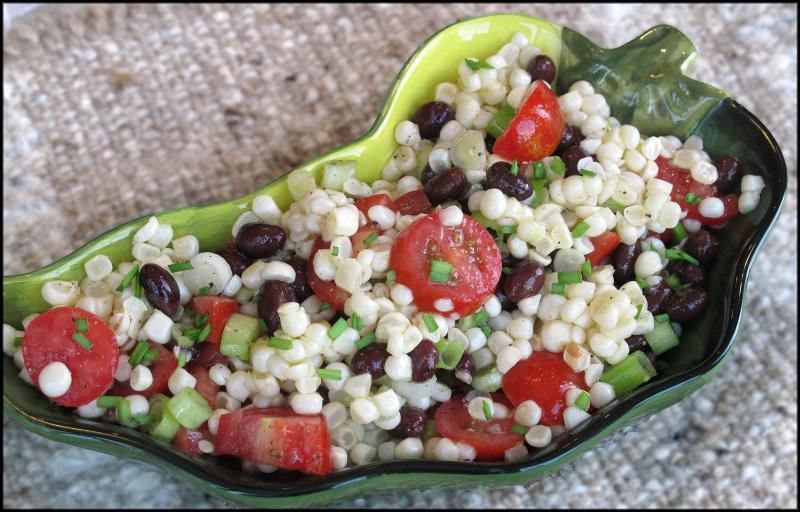Local summer sweet corn is at its peak
From the grocery stores to roadside stands to the weekly farmers markets, everyone is selling corn on the cob. And it’s not only on the menu; you’ll find corn is used in almost everything. From plastic dispenser bottles to the hand cleanser inside to the ethanol in your car’s gas tank to the glue holding the flaps of your morning cereal box. Not only do we humans enjoy eating corn, but it’s also widely used as livestock feed.
As the demand for corn has increased through the years, the number of different varieties of corn has become smaller. Today, flour corn is grown primarily in South America for the production of corn flour. Waxy corn (the result of a naturally occurring genetic mutation) was originally discovered in China and is now widely produced for a range of applications: food thickeners and stabilizers; adhesives for tape and envelopes; and animal feed.
Dent corn or field corn has high starch and low sugar content. It’s usually harvested when the kernels are dry and then processed into products like corn chips and tortillas or used for animal feed. Flint corn and calico corn are the colorful corncobs typically used for autumn decorations. They’re grown for popping corn, cornmeal, hominy, polenta and grits.
Sweet corn is what you’ll find during the next several weeks at markets everywhere. Because this type has a very high sugar content, it’s picked while still immature, before those sugars turn into starch and the ears lose that signature milky creaminess. It’s available in different color varieties ranging from delicate white to deep yellow or in bicolor types that have both white and yellow kernels on the same ear.
The final type of corn under cultivation is something we call “heirloom” corn. As agricultural industrialization placed more value on standardization, most large-scale farmers produced corn to meet that demand. Heirloom corn types, like any heirloom produce, are those varieties that have almost disappeared and are not mass-produced, but grown on smaller-scale farms.
The colors of heirloom corn range widely across the rainbow from light tans and yellows to deep blues and reds. Many of them have names that recall their origins as crops of Native Americans, such as Seneca Red Stalker, Cherokee White Eagle and Hopi Turquoise. There are a number of online sites that offer seed for these and other varietals if you’d like to try your hand at growing heirloom corn.
For those just-picked ears of local summer sweet corn, there are a number of ways to enjoy the creamy, crunchy texture of those juicy kernels. The salad in the photo could also be used as a topping for grilled chicken or fish as well as a tasty side dish for your picnic. There’s room for endless improvisation on other ingredients and no cooking necessary (avoid any recipes for corn salad that instruct you to boil the kernels first).
This one combined sliced grape tomatoes, black beans, green onion and seasonings in a lime juice and olive oil vinaigrette. The combination of textures, flavors and colors makes this a summertime favorite. If you must cook your corn kernels, use this basic recipe for a simple skillet sauté in butter. It tastes just like corn on the cob, without the work of biting across the ears in typewriter fashion.
For a more decadent presentation of fresh corn, consider stirring tender kernels into a creamy pasta carbonara. If you’re troubled about the egg yolks, replace them with egg substitute; just be generous with the Parmesan cheese.
Corn Salad
6 ears of corn
1 C sliced grape tomatoes
2/3 C drained black beans
2 sliced green onions
2 T olive oil
2 T lime juice
1 T vinegar*
salt & pepper, to taste
snipped chives
Slice kernels from ears of corn. In a serving bowl, toss together corn, tomatoes, black beans and green onions. In a small bowl, whisk together olive oil, lime juice and vinegar. Drizzle with dressing and toss to coat. Season to taste with salt and pepper. Garnish with snipped chives. *Note: choose vinegar based on flavor profile desired: rice wine vinegar adds slight sweetness; apple cider vinegar adds tartness; Balsamic adds deep sweetness; red wine vinegar adds heavy acidity. Yield: 4 to 6 servings.
Sautéed Corn
6 ears of fresh corn
2 T butter
salt and pepper, to taste
snipped chives
Cut the kernels from the ears; set aside. Melt butter in a large sauté pan over medium heat. Add corn kernels; sprinkle with salt and pepper. Cook for 3 to 5 minutes, stirring frequently until corn is heated through. Yield: 4 to 6 servings.
Corn & Pasta Carbonara
1 lb pasta
6 slices bacon, chopped
4 ears corn
3 minced garlic cloves
1 t minced thyme leaves
3 T chopped parsley
1/2 C dry white wine
3 egg yolks
1/2 C Parmesan cheese
Cook the pasta according to the package directions. Drain, reserving 1 C of the cooking liquid. Meanwhile, sauté the bacon until crisp; remove to a paper towel and set aside. Remove the kernels from the ears of corn and add to the same skillet. Cook gently for about 3 minutes. Add garlic, thyme and parsley; sauté for a minute or so. Add wine to deglaze the pan. In a small bowl, whisk the egg yolks until smooth; slowly stir in pasta water. Add the yolk mixture and the cooked pasta to the skillet and toss to combine. Remove from heat and stir in cheese. Garnish with additional Parmesan and parsley. Yield: 4 to 6 servings.





















































